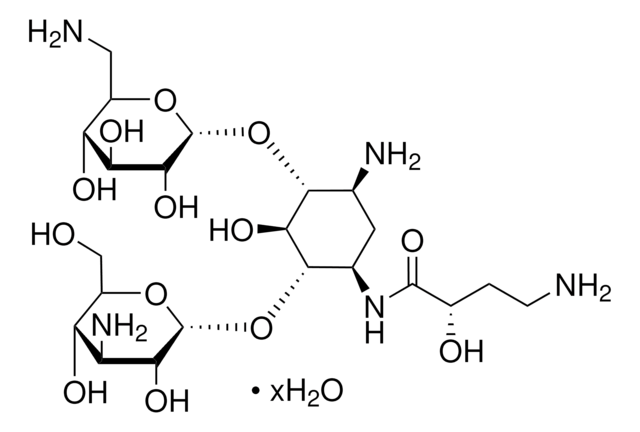K0879
Kanamycine sulfate from Streptomyces kanamyceticus
powder, γ-irradiated
Synonyme(s) :
Kanamycine sulfate salt, Kanamycine A
About This Item
Produits recommandés
Source biologique
Streptomyces kanamyceticus
Qualité
Molecular Biology
for molecular biology
Stérilité
γ-irradiated
Forme
powder
Puissance
≥700 μg per mg
Couleur
white to off-white
pH
6.5-8.5(1% solution)
Spectre d'activité de l'antibiotique
Gram-negative bacteria
Gram-positive bacteria
mycoplasma
Mode d’action
protein synthesis | interferes
Température de stockage
2-8°C
Adéquation
nonselective for Escherichia coli
nonselective for coliforms
Chaîne SMILES
OS(O)(=O)=O.NC[C@H]1O[C@H](O[C@@H]2[C@@H](N)C[C@@H](N)[C@H](O[C@H]3O[C@H](CO)[C@@H](O)[C@H](N)[C@H]3O)[C@H]2O)[C@H](O)[C@@H](O)[C@@H]1O
InChI
1S/C18H36N4O11.H2O4S/c19-2-6-10(25)12(27)13(28)18(30-6)33-16-5(21)1-4(20)15(14(16)29)32-17-11(26)8(22)9(24)7(3-23)31-17;1-5(2,3)4/h4-18,23-29H,1-3,19-22H2;(H2,1,2,3,4)/t4-,5+,6-,7-,8+,9-,10-,11-,12+,13-,14-,15+,16-,17-,18-;/m1./s1
Clé InChI
OOYGSFOGFJDDHP-KMCOLRRFSA-N
Vous recherchez des produits similaires ? Visite Guide de comparaison des produits
Description générale
Application
Actions biochimiques/physiologiques
Mode de résistance : les enzymes modifiant les aminoglycosides (dont l'acétyltransférase, la phosphotransférase et la nucléotidyltransférase) peuvent modifier cet antibiotique, l'empêchant alors d'interagir avec les ribosomes.
Spectre antimicrobien : Le sulfate de kanamycine est efficace sur les bactéries à Gram négatif, les bactéries à Gram positif et les mycoplasmes.
Principe
Notes préparatoires
Produit(s) apparenté(s)
Mention d'avertissement
Danger
Mentions de danger
Conseils de prudence
Classification des risques
Repr. 1B
Code de la classe de stockage
6.1C - Combustible acute toxic Cat.3 / toxic compounds or compounds which causing chronic effects
Classe de danger pour l'eau (WGK)
WGK 2
Équipement de protection individuelle
Eyeshields, Gloves, type N95 (US)
Faites votre choix parmi les versions les plus récentes :
Déjà en possession de ce produit ?
Retrouvez la documentation relative aux produits que vous avez récemment achetés dans la Bibliothèque de documents.
Les clients ont également consulté
Active Filters
Notre équipe de scientifiques dispose d'une expérience dans tous les secteurs de la recherche, notamment en sciences de la vie, science des matériaux, synthèse chimique, chromatographie, analyse et dans de nombreux autres domaines..
Contacter notre Service technique








